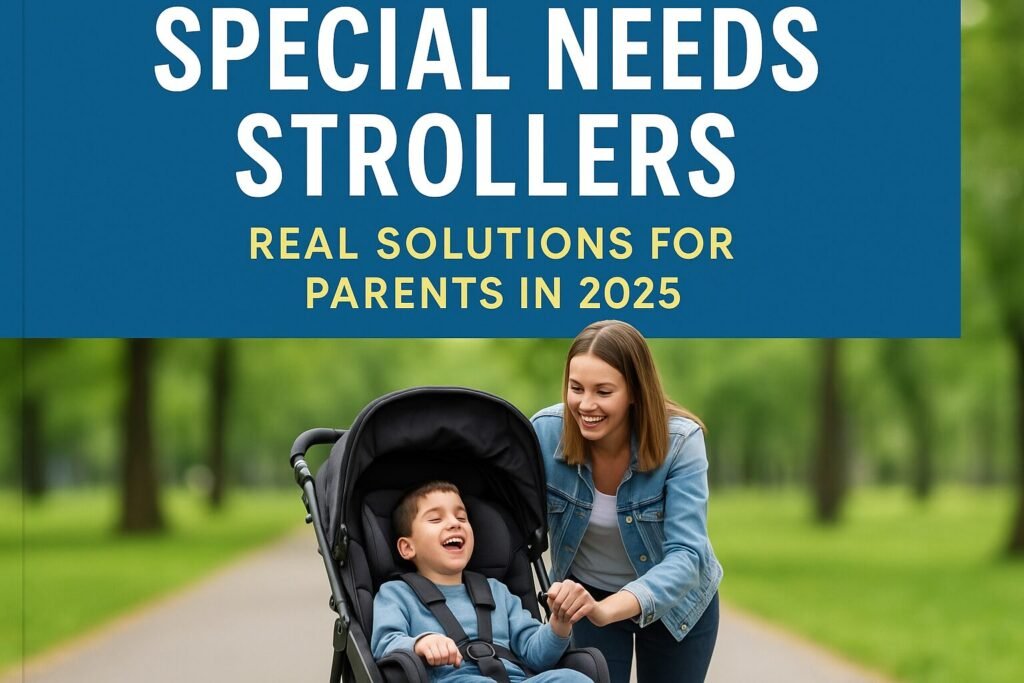What Is a Special Needs Stroller?
A special needs stroller is a type of mobility aid developed for toddlers and adults with physical, neurological, or developmental issues. Finding the right special needs stroller can make a big difference for both the kid and the person who looks after them.
These strollers that can be changed are more than simply standard mobility aids.. They give kids with disabilities, mobility challenges, or developmental delays freedom, safety, and comfort.
This full book is meant to help families with actual challenges and give them realistic, medically sound answers.
This blog will help you make a smart, confident choice in 2025, whether you want to break generational parenting if you are a caregiver, or therapist.
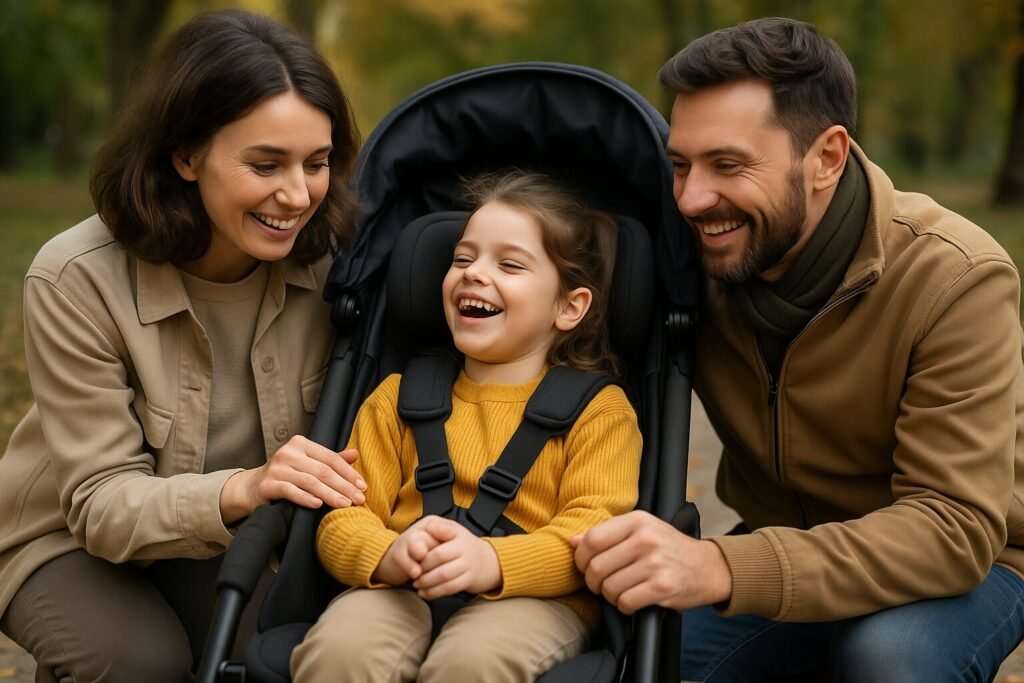
Why Choose a Special Needs Stroller?
1. Enhanced Mobility
Kids and teens with mobility problems sometimes have trouble walking long distances. Strollers for kids with special needs make it easier to go outside, go to therapy, and travel.
2. Postural Support
These strollers have reclining seats, adjustable footrests, head supports, and five-point belts to save you from getting hurt or uncomfortable.
3. Durability & Terrain Handling
Adaptive strollers are great for parks, sidewalks, trails, and city streets since they have strong frames, shock-absorbing wheels, and can go anywhere.
4. Portability
Many strollers for kids with special needs may be folded up, are light, and can be used in cars, which makes them great for families on the road.
Who Needs a Special Needs Stroller?
Special needs strollers are ideal for:
- Children with cerebral palsy
- Kids with low muscle tone
- Individuals with developmental delays
- Teens with autism spectrum disorders
- Adults with mobility impairments
- People with neuromuscular diseases
- Patients recovering from surgery or injury
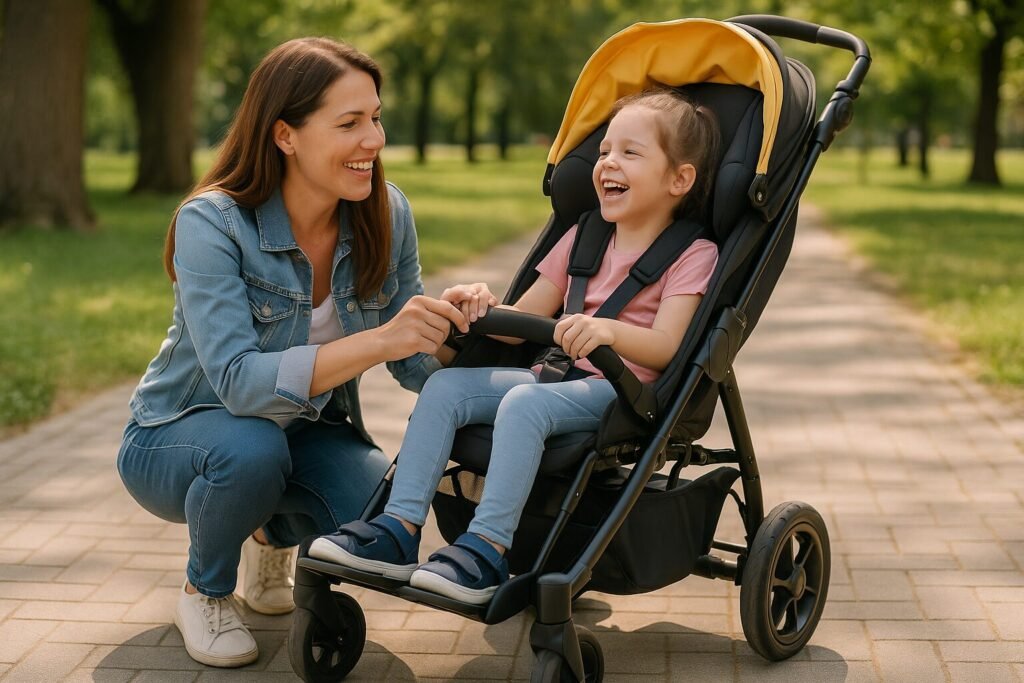
Key Features to Look For
Choosing the right disability stroller or adaptive stroller depends on the user’s age, weight, mobility needs, and daily lifestyle. Here are important features to consider:
✅ Adjustable Seating
Look for recline and tilt-in-space options to improve pressure relief and posture.
✅ Safety Harness
A 5-point harness system prevents falls and keeps the rider securely seated.
✅ Suspension & Wheels
Pneumatic tires and shock absorption systems make it easier to handle rough terrain.
✅ Weight Capacity
Many models can accommodate users up to 100 lbs, 150 lbs, or even 250+ lbs, perfect for older children and teens.
✅ Folding Mechanism
A compact fold helps caregivers store the stroller in cars or tight spaces.
✅ Storage Options
Storage baskets, backpacks, and accessory bags are often included for medical supplies, food, or toys.
✅ Sun & Rain Canopy
Weather-protective canopies shield from sun, wind, and rain—essential for outdoor use.
What is important in a Special Stroller?
A special needs stroller is a type of pediatric mobility equipment designed for children or young adults with physical disabilities, neuromuscular disorders, or developmental delays and mental health. Unlike standard strollers, these models include features such as:
- Higher weight and height capacity
- Advanced positioning and posture support
- Tilt-in-space and recline functions
- Adaptive safety harness systems
- Medical accessories (oxygen tank holders, IV poles)
Special needs strollers serve as an intermediate solution between a traditional stroller and a wheelchair, particularly for families seeking more mobility, comfort, and portability.
Common Challenges Parents Face — and Real Solutions
1. Standard Strollers Are Too Small or Unsafe
Many parents start noticing that their child has outgrown traditional strollers or struggles to sit upright safely due to poor trunk control.
Children with cerebral palsy, spina bifida, or muscular dystrophy often require seating that supports posture and prevents long-term complications.
Solution: Choose a special needs stroller with:
- Adjustable seat depth and height
- Lateral supports and harnesses
- Tilt-in-space or recline features for posture alignment
- Headrests and footrests for additional support
Recommended Models: Convaid Rodeo, Thomashilfen Swifty, Ormesa Bug
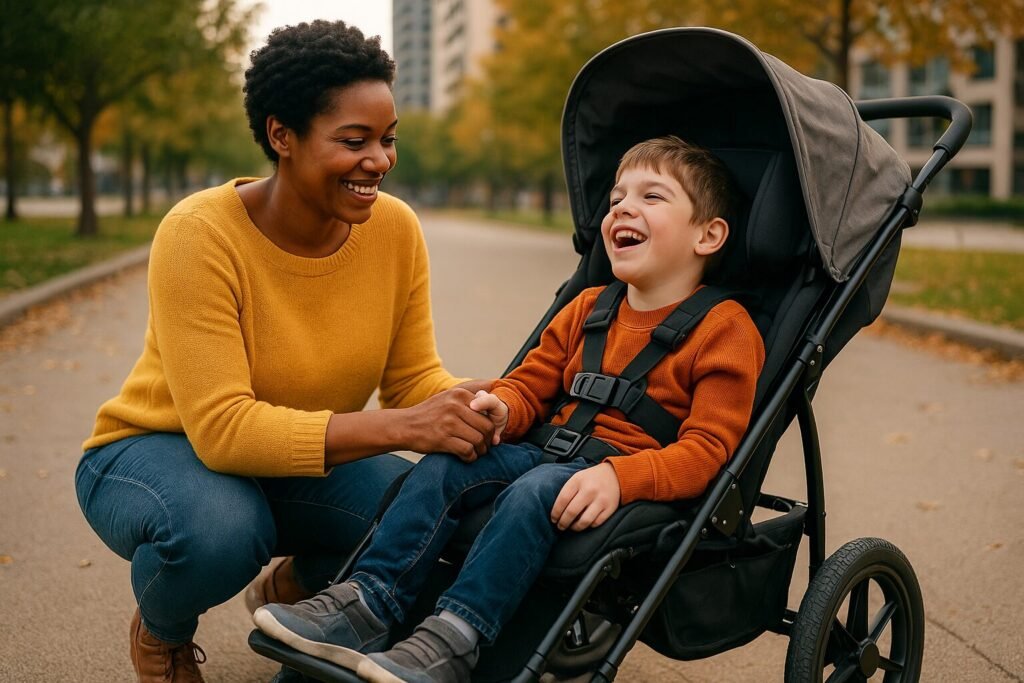
2. Transporting Adaptive Equipment Is Difficult
Families who travel or need to regularly transport their child face major struggles fitting bulky equipment in cars or on airplanes.
Solution: Invest in a lightweight, foldable adaptive stroller that meets airline and public transport requirements.
Features to Consider:
- Compact folding mechanism
- Lightweight aluminum frame
- Optional transit tie-downs (WC19-compliant)
- Car seat compatibility
Recommended Models: Maclaren Major Elite, Special Tomato EIO, R82 Cricket
3. The Child Dislikes Being Restrained
Some kids with autism, ADHD, or sensory processing disorder don’t like sitting in standard chairs because they are uncomfortable, sensitive to materials, or afraid of being restrained.
Solution: Pick a stroller that is constructed of soft, breathable, and non-restrictive materials. Look for designs that offer a wide seat base and calming support.
Key Features:
- Soft-touch fabrics
- Adjustable canopy to reduce visual stimuli
- Smooth recline function
- Quiet folding and locking mechanisms
Recommended Models: Special Tomato Jogger, Zoe XL5 Adaptive, Inspired by Drive Adaptive Cruiser
4. Insurance Won’t Cover the Costs
Some families may not be able to afford special needs strollers, which can cost anywhere from $800 to more than $3,500.
You can use insurance or Medicaid to pay for these costs, but the procedure might be hard to understand.
Solution: Work with a medical equipment supplier and get documentation from your healthcare provider.
Steps to Follow:
- Get a Letter of Medical Necessity from your physician or therapist
- Choose a stroller with an appropriate HCPCS code (e.g., E1234 to E1298)
- Submit claims through your insurance provider or Medicaid
- Explore alternative resources like:
- UnitedHealthcare Children’s Foundation
- Easterseals Equipment Loan Programs
- State-run disability support services
- Local adaptive equipment exchanges
- UnitedHealthcare Children’s Foundation
Bonus Tip: Many stroller brands offer financing options or payment plans to make the investment more manageable.
5. There’s No One-Size-Fits-All Option
Every child’s needs are unique. Some need reclining positions for muscle tone relief, while others require high-back support and firm seating for alignment. Some families need strollers that adapt over time as their child grows.
Solution: Focus on customizability and future-proof design.
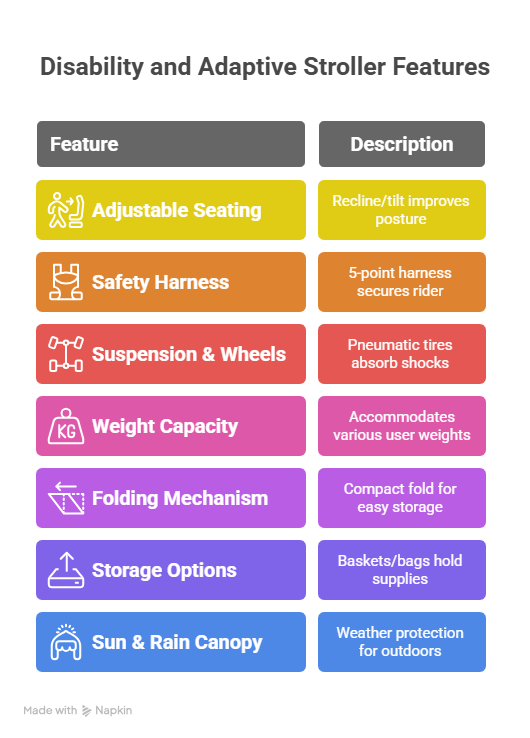
Considerations:
- Growth-adjustable frames
- Swappable parts and accessories
- Modular seating systems
- Multi-position tilt and recline
Consult a physical therapist or occupational therapist to ensure the stroller meets clinical requirements and daily lifestyle needs.
How to Choose the Best Special Needs Stroller
Here is a breakdown of the most important features to consider when selecting the right stroller for your child:
| Feature | Why It Matters |
| Weight Capacity | Ensures longevity as the child grows |
| Seating Adjustability | Supports different medical needs and postures |
| Tilt-in-Space or Recline | Provides pressure relief and comfort |
| Portability | Essential for travel and vehicle transport |
| Canopy & Weather Protection | Keeps the child safe from sun, rain, and wind |
| Medical Accessory Support | Holds oxygen, IV poles, or feeding pumps |
| WC19 Certification | Allows the stroller to be used in motor vehicles |
Top-Rated Special Needs Strollers in 2025
| Model Name | Weight Limit | Recline | Travel-Friendly | Price Range |
| Special Tomato EIO | 90 lbs | Yes | Yes | $700–$900 |
| Convaid Rodeo | Up to 170 lbs | Yes | Yes | $2,500+ |
| Maclaren Major Elite | 65 lbs | No | Yes | $400–$500 |
| Thomashilfen Swifty | 110 lbs | Yes | Moderate | $1,800–$2,000 |
| Ormesa Bug | 80–120 lbs | Yes | Yes | $2,200–$3,500 |
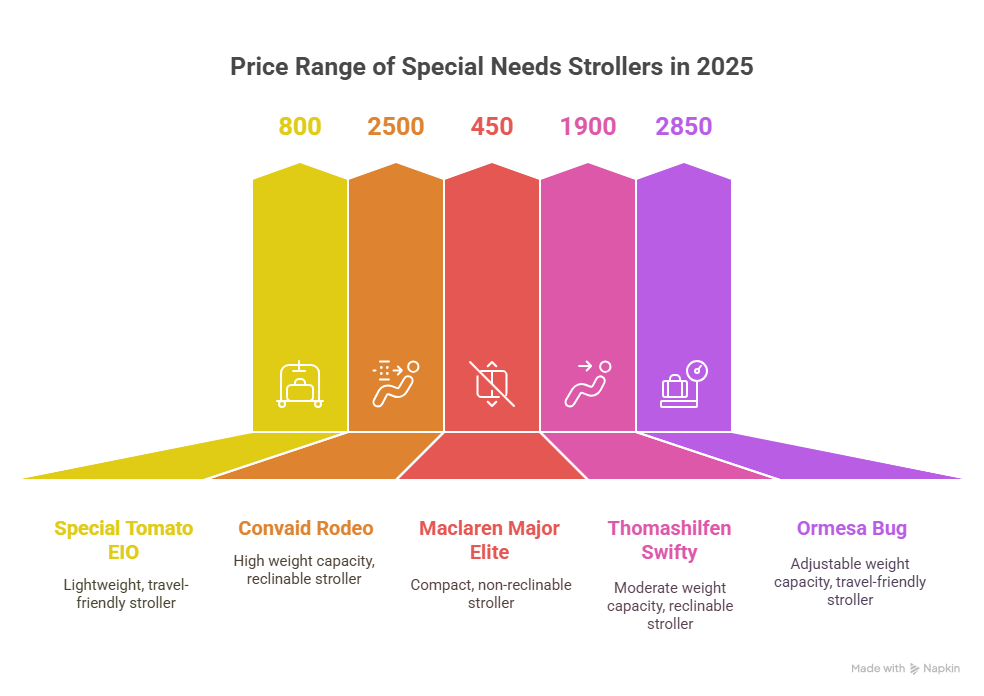
Final Thoughts: Empowering Families Through the Right Mobility Choice
Choosing the proper special needs stroller is about more than just getting around. It’s about letting your child safely explore the world while still feeling good about themselves.
The correct stroller can help caregivers stay awake, improve posture, and allow them the mobility they need to live and travel.
When looking at your options, always put functionality, safety, and long-term adaptability first.
Talk to doctors and look into insurance or funding programs to make sure you get the finest care and the greatest deal.

